Steem Blockchain: STU, Reputation, Author/Curator Ratio, etc.- Steemit Crypto Academy- S4W7- Homework Post for @sapwood
This is my homework post for Steemit Crypto Academy Season 4 Week 7 of Professor @sapwood’s class of Steem Blockchain: STU, Reputation, Author/Curator Ratio, etc.-.

Task 1 – STU (STEEM Token Unit)
1.1. STU and Its Break-Up
STU, in the world of STEEM, stands for STEEM Token Unit, which is a unit used to measure the amount of rewards obtained by contents created in the Steemit ecosystem, which will be shared between creators (Authors) and Curators.
- Authors are people who create and upload content to the Steemit ecosystem, either in the form of articles (posts) or comments.
- Curators are people who curate other people's articles. Curating is upvoting or downvoting.
STU might contain three types of rewards when broken-up: 1) SBD (short for STEEM Backed Dollar), 2) SP (short for STEEM Power), and 3) STEEM. Of the three types of rewards contained in STU, SP will always be there, while SBD and STEEM availability is subject to be determined by the dynamics of STEEM and SBD in the market which is known as Debt Ratio. So, the composition of STU content might have three possibilities, according to market conditions, namely:
- SBD + SP
- STEEM + SBD + SP
- STEEM + SP
How to calculate the Debt Ratio has been explained quite clearly by Professor @sapwood in his article on Steemit which was uploaded on September 24th 2020, entitled Understanding- Debt Ratio & its effect on Author Payout.
1.2. Indicating STU From A Post
On the list of articles (on the blog or posts segment), the STU is shown below each entry, between the curation (upvote and downvote) buttons and the number of curators. For example, the following image, a screenshot of the Post segment of my Steemit account.

Meanwhile, on a single article page, STU is visible at the bottom of the article. As an example is shown by the following screenshot image.

1.3. STU to USD Calculation Example: Case of My Last Post Payout
1.3.1. The Last Post Payout
My latest post at time of writing is In-depth Study of Market Maker Concept as shown on the picture below.
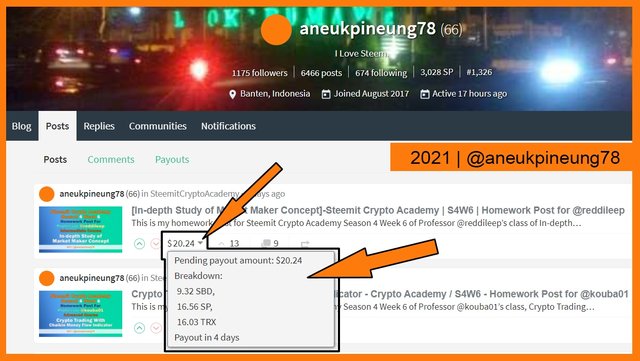
The picture above shows that the Post Payout is 20.24 STU. It is still pending because the article has not yet reached the age of 7x24 hours. This number can change later, depending on several things, especially if there is a change in the vote (there is an increase or decrease in votes or downvotes from owners of significant reputation and power).
So, it is more relevant to take an example from an article that has already in the Past Payout period ("mature", the age has passed the 7x24 hour period). Below is the screenshot image of the payout breakdown of my post that has passed the payout period, entitled Bitcoin's Trajectory, a homework post for Steemit Crypto Academy.
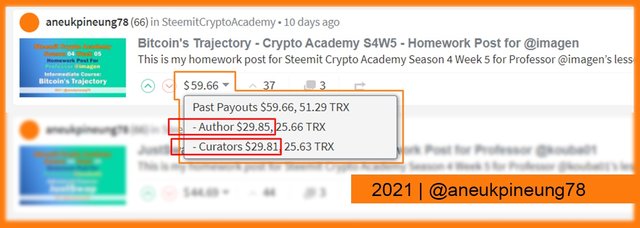
The figure shows a total payout of 59.66 STU, with a breakdown:
- Author: 29.85 STU
- Curators: 29.81 STU
1.3.2. The Calculation of My Last Post Payout
1.3.2.1. The Preparation
Now it’s time to calculate what I (as the author) and curators get from the post payout. I need two information before I can proceed further: 1) the SBD Print Rate and 2) the STEEM Price Feed.
To check the SBD Print Rate, I use the SteemDB Steem Blockchain Explorer and I see this information:
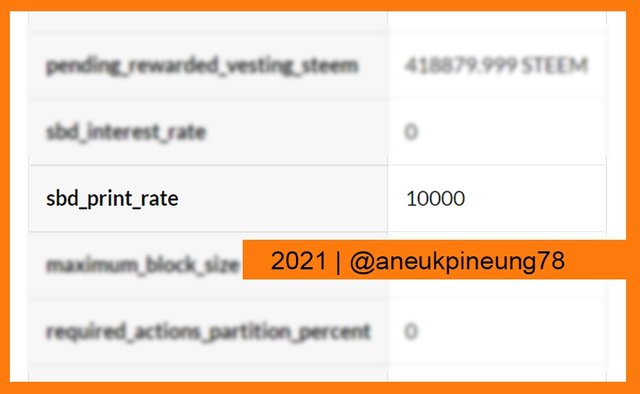
SBD Print Rate as seen on steemdb.io at time of writing. I go to steemscan.com to get the latest STEEM Price Feed and I see the information as seen in the screenshot image below:
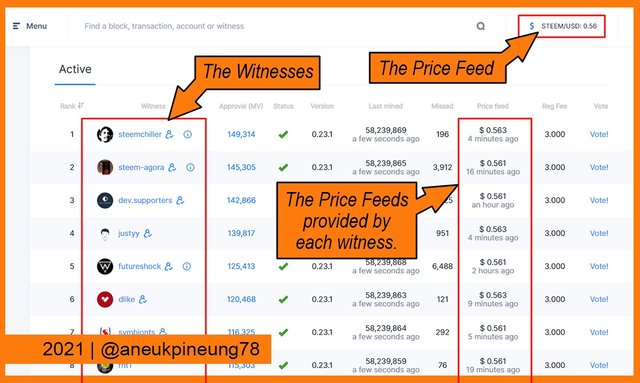
Screenshot image of steemscan.com.
1.3.2.2. The Author Reward Calculation
The screenshot image from SteemDB above shows the figure of 10000 SBD Rate which means 100% SBD Print Rate. And the steemscan.com shows that the STEEM Price Feed is 0.56.
Let’s just assume that when the post reached its maturity three days ago that the SBD Print Rate was also 100% (the fact is it was), that means the author (I) was rewarded with SBD and SP. Here was what I got as the author from the reward of 29.85 STU:
- SBD = 50% of 29.85 = 14.925
- SP is calculated with this formula:

The formula to calculate the author SP allocation from their reward STU.
or

The formula to calculate the author SP allocation from their reward STU.
So, for 29.85 STU, I got this much of SP:
SP = 29.85 / (2*0.56)
SP = 29.85 / 1.12
SP = 26.65
So, in total, for the post, the author’s reward was as much as 14.925 SBD and 26.65 SP. In term of USD, as per price data at time of writing:
- 1 SBD = USD 7.11[source:CoinGecko]
14.925 SBD = USD 106.117 - 1 STEEM = USD 0.562[source:CoinGecko]
26.65 SP = USD 14.977
Total in USD = 106.117 + 14.977 = 121.094. The table below should simplify it:
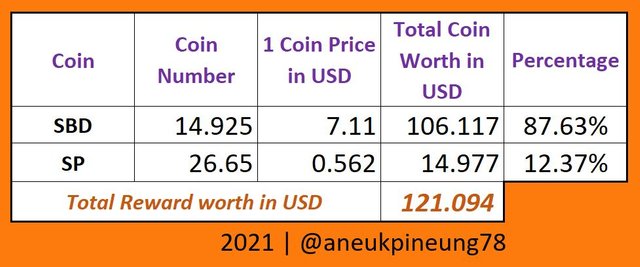
The Comparison of Author SBD : SP Reward (in term of USD) can be drawn in a pie chart as follow:
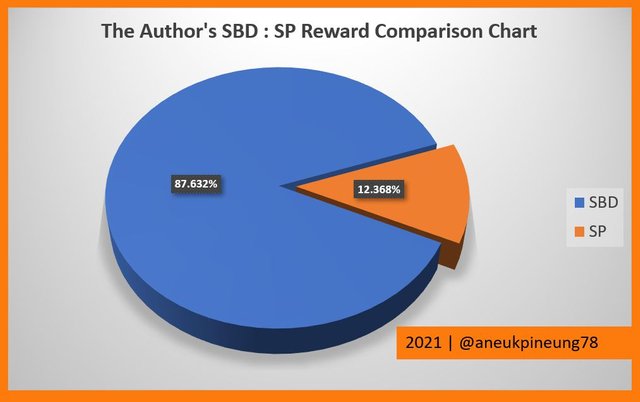
1.3.2.3. The Curators Reward Calculation
Curators only got rewards in form of SP. To calculate the value in term of USD is simply by dividing it with the STEEM Price Feed. In this case, the curators reward was 29.81 STU, so the SP value was as much as:
SP = 29.81 / 0.56
SP = 53.23
That 53.23 SP to be divided among curators based on their SP and Voting Power they used to curate. In USD, 53.23 is equivalent to USD 29.92 (1 STEEM = USD 0.562).

Task 2 – STEEM Reputation: Raw and Simplified Versions
2.1. Converting My Steem Account Raw Reputation Score To Simplified Reputation
Raw Reputation Score can be seen on the steemd.com page. To see one’s account on steemd, it can be done by just writing one’s Steem username behind the steemd.com homepage address. For example, my steemd account is: https://steemd.com/@aneukpineung78.
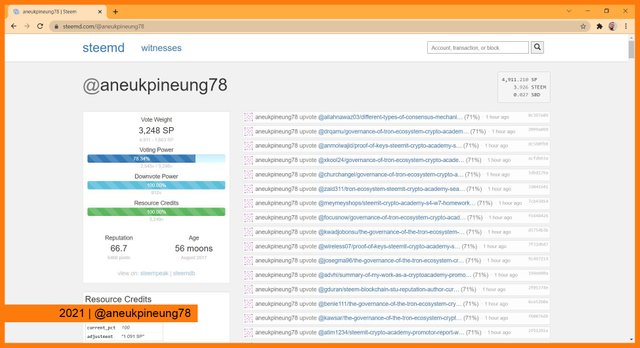
Next I scroll down the page until I see the Reputation info on the left pane of the steemd page. The Raw Reputation Score is 42,966,390,483,224.
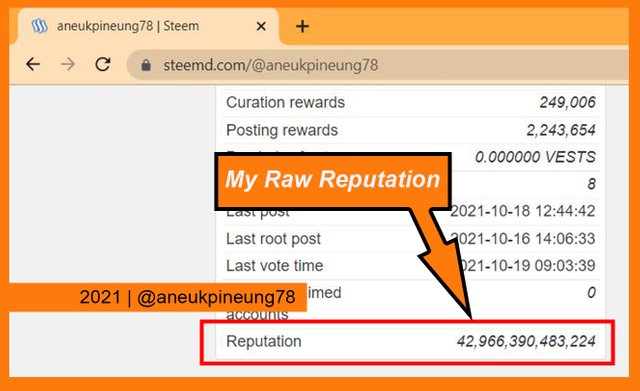
I put the number in to the formula to check for my Steem Reputation. The picture below shows the step by step calculation.
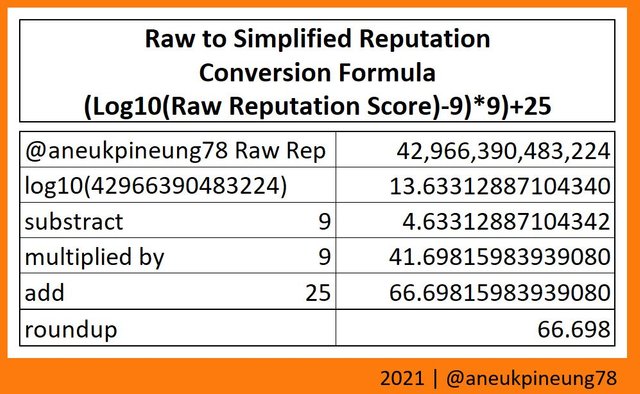
The calculation as shown on the picture above shows the result 66.69816.
2.2. What steemworld.org Says About It
I check my Steem Reputation on SteemWorld and it shows the same number.
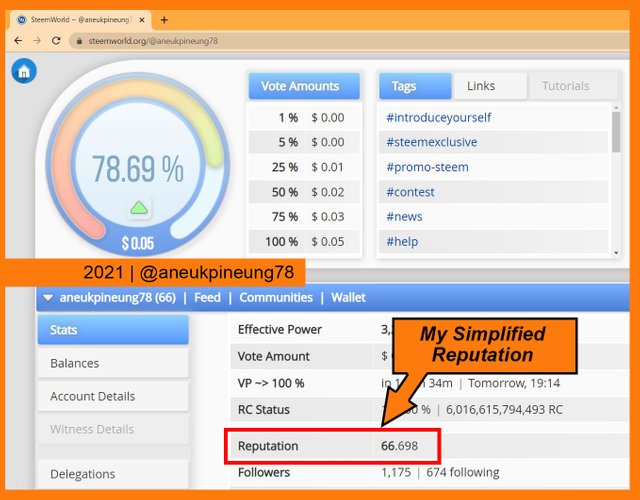

Task 3 – Liquid Rewards and Author:Curator Ratio Calculation
3.1. Liquid Rewards Percentage From My Last Post Payout in Term of USD Equivalent
As shown at Task 1 above, the author and curators reward for the case post in term of USD equivalent at time of writing is:
- Author:
- SBD = 14.925 * USD 7.11 = USD 106.117
- SP = 26.65 SP * USD 0.562 = USD 14.977
- Curators:
- SP = 53.23 * USD 0.562 = USD 29.915
So, the liquid reward produced by the post was equivalent to USD 106.117 and the staked reward was worth of USD 14.977 (of Author’s) + USD 29.915 (of Curators’) = USD 44.893. That makes the total reward worth of USD 151.009.
The liquid reward percentage = (Total SBD amount in USD equivalent : Total reward in USD equivalent) * 100%
= (USD 106.117 / USD 151.009) * 100%
= 70.272%
Below is the detail table of the total reward and the SBD:SP (liquid:staked) ratio.
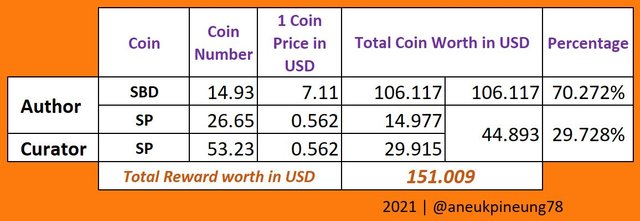
Below is the pie chart of total reward and the SBD:SP comparation (liquid:staked ratio) in percentage value, based on the USD equivalent calculation.
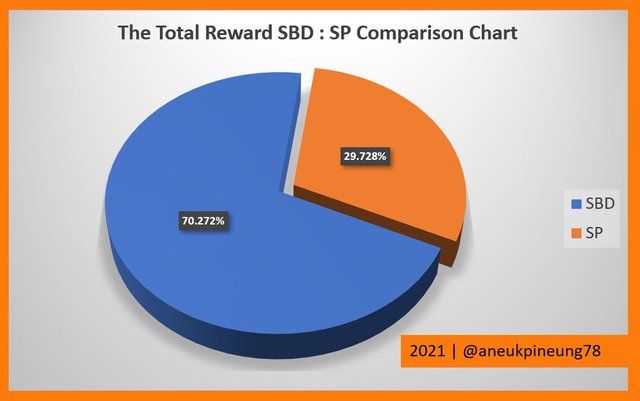
3.2. The Rise of SBD and Its Supply Dynamics
Ideally, SBD is set to have a price of USD 1 per 1 SBD. But based on data at the time of writing, the price of SBD has soared to USD 7.11 per 1 SBD. That means more than 7 times the ideal price. Meanwhile, as of time of writing, the price of 1 STEEM is USD 0.562. This means that the price of 1 SBD is around 12.65 STEEM. That's a very far-reaching comparison.
The high difference between the SBD and STEEM exchange rates against the USD, caused the Proof of Brain (PoB) blockchain stipulation to "generate only 25% of rewards as liquid rewards" (in USD terms) has been "violated". Based on the example of the post payout case that we reviewed above, the liquid reward (SBD, based on the USD exchange rate) is produced more than 70%.
The higher the SBD price compared to the STEEM price (the lower the STEEM:SBD ratio), the more STEEM needed to back up 1 SBD. In the case above, it takes 12.65 STEEM to back up 1 SBD. This means that the STEEM:SBD ratio is 1:12.65, which is very low.
When more STEEM is needed to back up 1 SBD and breaks the Debt Ratio limit, the supply dynamics will form a new pattern: reducing SBD supply and increasing STEEM supply in STU composition. This means that the STU composition in the reward can change from SBD + SP to SBD + STEEM + SP or even STEEM + SP.
Changes in the composition of STU are determined by the value of the Debt Ratio, which follows the following rules:
- If Debt Ratio is below 9%, then Authors will be rewarded in SBD + SP
- When the Debt Ratio is between 9% and 10%, Authors will be rewarded in SBD + STEEM + SP, and
- If the Debt Ratio is above 10%, Authors rewards will be in the form of STEEM + SP
The composition (ratio) of STEEM and SBD printed in STU when Debt Ratio limit is broken, is subject to Debt Ratio percentage value. Any reader who happened to haven’t already known abaut Debt Ratio, please head to this post of Professor @sapwood’s.
3.3. The Ratio of Author:Curator Reward per the Case Post
The reward comparison between Author and Curators for the case post at task 1, in term of USD equivalent, is :
- Total Author reward in USD = 121.094,
- Total Curators Reward in USD = 29.915
- The Author:Curators reward ratio = 121.094 : 29.915
The Author:Curators reward ratio = 80.190% : 19.810%
The reward comparison can be drawn in a table as shown below,
| Author | ||
| Curators | ||
| Total | ||
Below is the pie chart for Author:Curators rewards ratio.
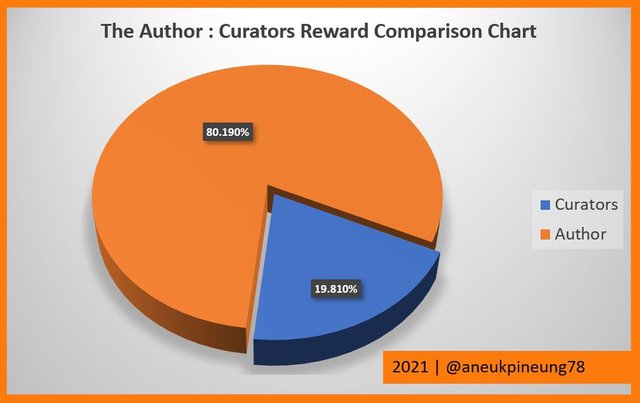

Task 4 - #club5050 and the Demand/Supply Dinamics in Favor of STEEM
4.1. What I Know About #club5050
In my understanding, #club5050 is an initiative that invites authors not to cash out 100% of their liquid rewards. Through this initiative, at least 50% of the liquid rewards received is used to power up. Take for example the case in Task 1 above, where the author received a liquid reward of 14.925 SBD. It is expected that at least 7.4625 SBD of that amount is used to power up.
4.2. How and Why It Can Shift the Demand/Supply Dynamics in Favor of STEEM
The more liquid rewards are powered up, the more the gap between the STEEM value and the SBD value will be reduced. In other words, the STEEM/SBD ratio will be in better value.
Take for example in the case above, the ratio of the total liquid:staked reward is 70.27:29.73. Say then, if 50% of the author liquid reward (50% * 14.925 SBD = 7.4625 SBD) is powered up. With a STEEM/SBD ratio of 1/12.65, 7.4625 SBD will provide 94.4006 SP. Then the table of total reward equivalent to USD for the case post will be like this one below:
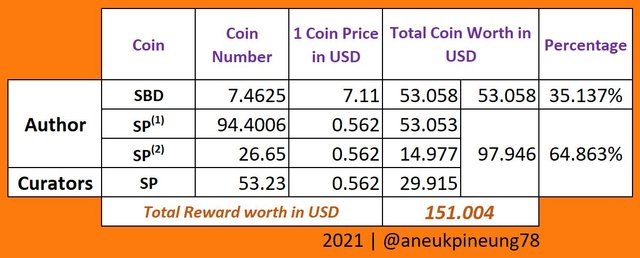
The pie chart for the data is like this one below:
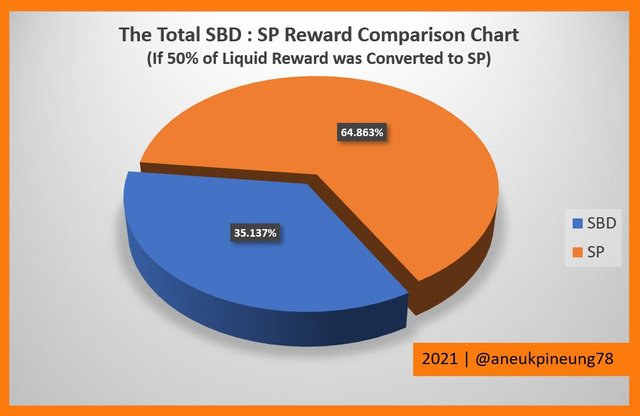
Below is the comparison table of 0% and 50% liquid reward powered up in equivalent to USD value:
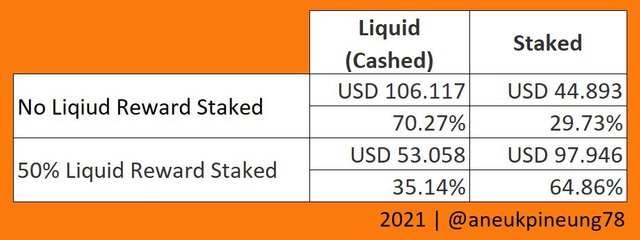
And below is the comparison in bar chart form.
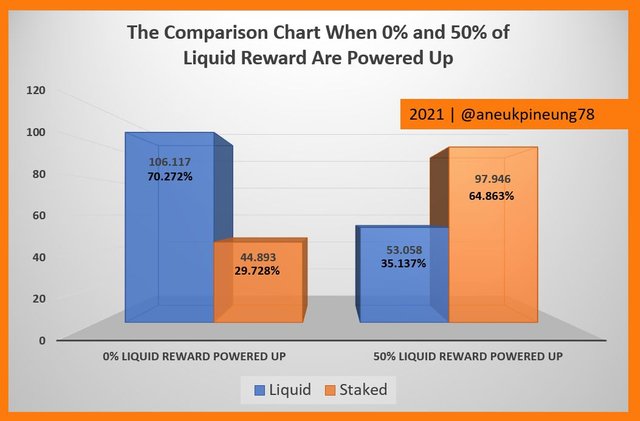
The above calculation simulation shows how by converting only 50% of liquid reward could “turn the table” and greatly change the liquid:staked reward ratio from 70.273%:29.782% to 35.137%:64.863%. In turn, this will increase the STEEM/SBD ratio, in other words, it will take less STEEM to back up 1 SBD, and the Debt Ratio will get lower and stay on its “desirable” value, and the STEEM ecosystem won’t be forced to print more STEEM and less SBD in the STU. I think that's how #club5050 can help STEEM in supply/demand dynamics.
I am now one of the #club5050 members.

Task 5 – Lower Reputation Users and Their Upvotes and Downvotes Impact
5.1. The Affect of Upvote and Downvote
If a user with a reputation lower than mine upvotes my post, it would basically increase the post payout and my reputation. How much the upvote increases the payout and reputation is determined by how much STEEM Power (SP) the upvoter has and how much VP (Voting Power) was used when upvoting.
If the same user downvotes my post, it would reduce the reward payout, how much the reward would be reduced is determined by the SP they have and the VP used. The downvote would not affect the reputation.
So, the three key aspects are: upvoter's SP, VP used, and upvoter's reputation.
5.2. Why and How
Why and how an upvote from a lesser reputation user has an effect on author reputation and post payout, while a downvote from a lesser reputation user only affects post payout but not author reputation, perhaps can be explained by this theory from @dantheman's article from 5 years ago, entitled Brief Update on Reputation Score:
Reputation score works by analogy that resembles the strength measurement of an earthquake, the Richter scale, using the mathematical function log base 10. Therefore, every reputation score is 10 times stronger than the previous reputation score, for example reputation 45 is 10 times stronger than reputation 44. Hence a reputation cannot be harmed by lesser reputation. For example, reputation 44 cannot harm reputation 45 (reputation 44's downvote will have no effect on reputation 45).
5.3. Example
5.3.1. Case 1: Upvote
UserX with reputation 55 (which is lesser than 66, my reputation) has 5000 SP upvotes on my post with 50% Voting Power. The upvote will increase the post payout and my reputation. The same (the post payout and my reputation increase) happens when UserY with reputation 62 does the same, but UserX’s upvote generates more rewards to the post even though he has lesser reputation than UserY’s, since UserY has only 3000 SP even though they use the same VP strength, 50%. This will be different if, for example, UserX uses 10% VP while UserY goes with 100% VP.
The real example on how upvotes from lesser reputation users and their SP and VP used affect my post payout is shown on below picture.
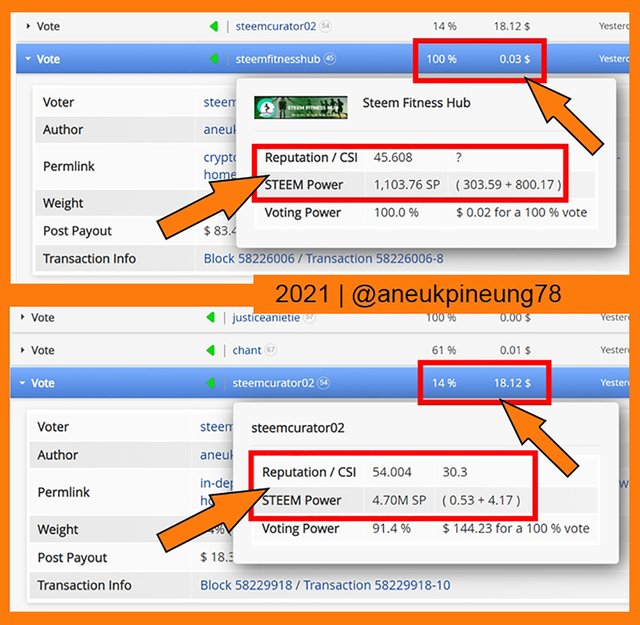
The picture above shows us this detail:
The data above shows us the correlation of SP one account has, and the generated reward of their upvote, with the determination of VP used. The basic laws about this are:
- the more SP you have, the more rewards your upvote generates, and vice versa;
- the more VP you used when upvoting, the more rewards your upvote generates, and vice versa.
5.3.2. Case 2: Downvote
A downvote from any user with lower reputation than mine will decrease the post payout. How much reward decrease it causes depends on the SP and the VP used. The comparison example is: If UserX (Reputation 55, 5000 SP) and UserY (Reputation 62, 3000 SP) downvote my post at the same VP percentage (say 100% VP), then UserX will cause the more decrease to the post payout that what UserY will. But since both of them have lesser reputation than mine, the action won’t have any effect on my reputation. Simply put: they can’t hurt my reputation, only my wallet.

Thanks
Thanks Professor @sapwood for the lesson titled Steem Blockchain: STU, Reputation, Author/Curator Ratio, etc.-.
Pictures Sourcing
- The editorial picture was created by me.
- Unless otherwise stated, all another pictures were screenshoots and were edited with Photoshop CS 3.
Sources and Reading Suggestion
- https://steemit.com/hive-108451/@sapwood/crypto-academy-season-4-or-advanced-course-week-7-steem-blockchain-stu-reputation-author-curator-ratio-etc;
- https://steemit.com/hive-196725/@sapwood/understanding-debt-ratio-and-its-effect-on-author-payout;
- https://steemit.com/steemexclusive/@sapwood/understanding-pob-curation-and-voting-in-steem-blockchain;
- https://steemit.com/steemit/@youngjerv/s-t-u-steem-token-unit-steem-and-how-rewards-are-been-split-between-authors-in-sbd-steem-power-and-usd-explained;
- https://steemit.com/steemtokenunit/@youngjerv/understanding-s-t-u-steem-supply-rewards-algorithm-upgrade-and-how-rewards-are-been-split-between-authors-in-sbd-steem-power-and,
- https://www.steem.center/index.php?title=Reputation_System;
- https://www.steem.center/index.php?title=Main_Page
- https://steemit.com/steemit/@digitalnotvir/how-reputation-scores-are-calculated-the-details-explained-with-simple-math;
- https://steemit.com/steemit/@dantheman/brief-update-on-reputation-score;
- https://steemit.com/reputation/@moeknows/some-interesting-facts-about-reputation-on-steemit;




Shared to Twitter: https://twitter.com/aneukpineung78a/status/1451886120241799176.
#club5050 😀